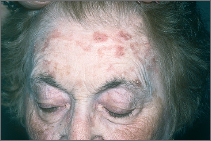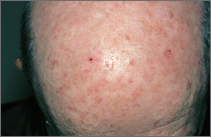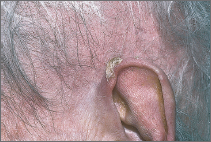Solar keratoses, also known as actinic keratoses, are the most common sun-related skin growths.
A solar keratosis is benign (nonmalignant); however, it does—if left untreated—have the potential to develop into a type of skin cancer, squamous cell carcinoma.
An estimated 1 in 20 lesions eventually turns into squamous cell carcinoma.
The good news is that the squamous cell carcinomas that develop from these solar keratoses are a very slow-growing, unaggressive type of skin cancer, and the prognosis is usually excellent. Distant metastasis (spread) is extremely rare.
Solar keratosis on the nose
They usually appear as crusty, “dry,” scaly bumps that are typically rough-textured and sandpaperlike to the touch.
Sometimes they are skin colored, reddish, or yellowish. They may also be tan or dark brown in color (pigmented solar keratosis).
They can gradually enlarge, thicken, and become more elevated and form “cutaneous horns” (they resemble a horn of an animal and often arise on the ears).
Solar keratoses
Solar keratoses are most often seen on a background of sun-damaged skin or on any area that's repeatedly exposed to the sun.
They appear mainly on the face, especially on the nose, temples, forehead, and sometimes on or around the lips. They also commonly arise on the top of the forearms and hands.
In men, they are commonly noted on the bald areas of the scalp, the tops of ears, and the sun-exposed areas of the neck.
Solar keratoses on the scalp
Solar keratoses are seen in people who are fair-skinned, burn easily, and tan poorly.
They are more common in men, particularly those who work in outdoor occupations, such as farmers, sailors, and gardeners, and those who participate in outdoor sports.
The rate of occurrence is highest in Australia and in the Sun Belt of the United States. Solar keratoses are rare in dark-skinned people.
Cutaneous horn overlying a solar keratosis
Very small solar keratoses are more easily felt than seen. They feel like gritty bumps.
Larger ones are diagnosed by dermatologists based on their appearance or a skin biopsy.
Treatment involves destruction of solar keratoses.
Topical chemotherapy (you need a prescription)
Application of a 5-fluorouracil cream (5-FU) may be used when solar keratoses are too numerous to treat individually. Topical 5-FU treatment can be likened to using a “smart bomb,” in which the “bomb”—in this case 5-FU—targets only the “enemy”—the rapidly growing abnormal cells.
Topical Aldara (imiquimod) cream or Solaraze (diclofenac) may also be self-administered.
Outline




